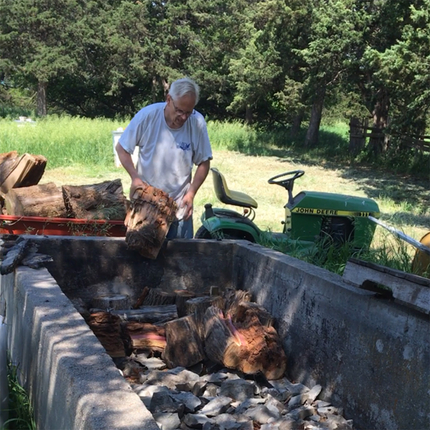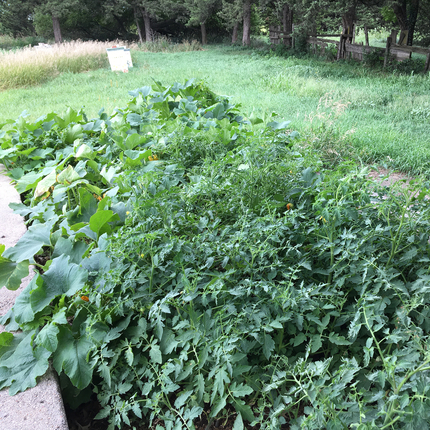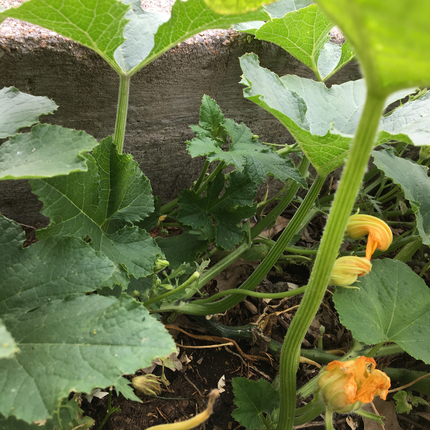It's official! The first day of 2022 is here. We present our most viewed blog post of 2021, authored by Kayla Bergman in January.
Featuring one of our board members, this piece takes a look at a creative way to use an old cattle cistern. Nancy and Alan used their time during the pandemic to figure out the "Hugelkultur" technique. (IMO, we have some pretty awesome board members!)
If you missed any of the top 5 blogs of 2021 you can click to read them here: #2 Applying for Paycheck Protection Program loan forgiveness, #3 From the desk of the executive director: Dollar General seeks to reshape small towns, #4 Fullerton residents have a new reason to be fired up about fitness, and #5 Catholic priest finds a new way to serve his community.
These stories are just a sample of what we've done this year. Thank you for reading our blog in 2021. We look forward to writing for you and working for rural America during the next year and beyond.
Center for Rural Affairs board member Nancy Meyer and her husband, Alan, of Cedar Bluffs, Nebraska, used their time at home during the pandemic to make use of an old cattle cistern on their farmstead.
Among their old barns, solar panels, and beehives sits a cattle trough that dates back to 1904 and is 13 feet long, 4 feet wide and 3 feet deep. Since they do not have cattle and had never made any use of the cistern, the Meyers decided it might be ideal for trying out a technique called “Hugelkultur.”
The German term (pronounced “hugh-gul-kul-tor” in English) means “hill culture” and describes a method of layering wood debris and soil or compost to promote rotting. The woody material, as it absorbs moisture from the soil, decays and releases nutrients and warmth, creating an ideal environment for nurturing plants.
“Hugelkulturs” vary from simple debris mounds or piles covering stumps, to straight or circular or meandering berms. They can be as large and long as desired, and can be arranged in patterns of disjointed straight and/or curved pieces. “Hugelkultur” berms and hills can serve dual purposes, such as providing terracing or vertical gardens. In addition, the method can be used in almost any type of large planting vessel. It is especially good for saving the expense of buying potting soil or other fill material for container gardening.
Nancy said “Hugekultur” is also a good way to get rid of organic waste material that would otherwise need to be burned, releasing carbon into the air.
“Basically, the technique simply speeds up the natural process of wood rotting on a forest floor and sequestering carbon,” she said.
The result of their work was an unexpectedly happy one, producing what the Meyers called, “the garden we didn’t plant.”
To create the “Hugelkultur,” the couple put rocks and recycled broken concrete in the bottom of the cistern, then added a layer of firewood packed tightly together and facing upward. Next, they spread sticks and branches, followed by leaves, ashes, and some soil. They topped the whole thing with composted kitchen scraps. To keep the moisture content high during a dry summer, Alan watered the trough weekly.
Squash and tomato plants soon appeared.
“They immediately germinated from the compost and grew to maturity, much to the delight of our bees living in the three hives nearby,” Nancy said. “This was an unexpected bonus as the container allowed for squash vines to spill over the sides, making it look nice and allowing us to avoid the management of vines like we do in our regular vegetable garden.”
Because of the amount of air in the “Hugelkultur,” especially from the layer of branches, there was some subsidence—the gradual caving in or sinking of an area of land—which the Meyers expected.
The subsidence actually indicated the experiment was working because it meant the wood was decaying as planned. The Meyers also noticed some tunneling by small animals, which they did nothing to discourage as they considered it a natural form of soil aeration.
“The burrowing animals provided us with an ecosystem service,” Nancy said. “We weren’t going to discourage that.”
By the end of the summer, the surface of the “Hugelkultur” was 8 to 12 inches from the top, indicating 4 to 6 inches of subsidence overall.
“In the fall we simply left the dead plants in place and dumped more leaves and soil on top,” Nancy said.
“Next spring, we will probably cover that with more yard debris, ashes, and compost, and start the process again. At some time we may use the ‘Hugelkultur’ as a source of clean, rich garden soil, but we will continue to allow and encourage squash and other useful plants to grow in it.”






